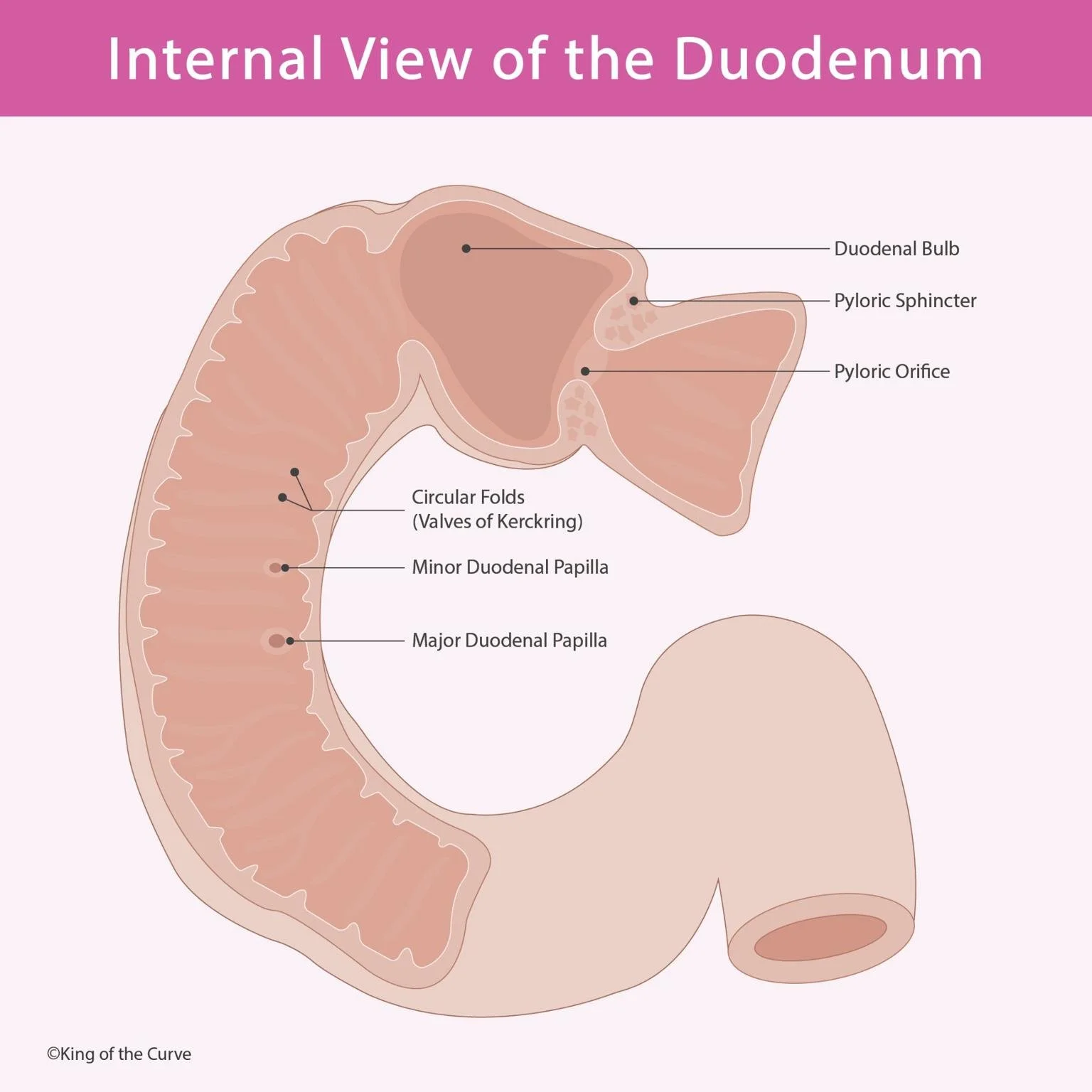🧠 Internal View of the Duodenum: The Gateway of Digestion
The duodenum, the first section of the small intestine, plays a vital role in digestion by receiving partially digested food from the stomach and mixing it with digestive enzymes and bile. This process prepares nutrients for absorption further down the gastrointestinal (GI) tract.
🔬 Anatomy of the Duodenum
As shown in the illustration, the duodenum’s internal features include:
Duodenal Bulb: The first portion of the duodenum immediately after the pylorus. It’s smooth and lacks folds, making it a common site for peptic ulcers.
Pyloric Sphincter: Regulates the passage of chyme from the stomach into the duodenum.
Circular Folds (Valves of Kerckring): Large mucosal folds that increase the surface area for absorption and slow down the passage of chyme.
Minor Duodenal Papilla: Drains the accessory pancreatic duct (if present).
Major Duodenal Papilla: The entry point for bile and pancreatic enzymes from the hepatopancreatic ampulla (Ampulla of Vater).
These structural features ensure that food is mixed thoroughly with digestive secretions and that nutrients are absorbed effectively.
⚙️ Function and Physiological Significance
The duodenum serves as a hub of digestive activity. It neutralizes acidic chyme using bicarbonate from the pancreas and initiates fat, protein, and carbohydrate digestion through enzyme action. The Brunner’s glands, found in its submucosa, secrete alkaline mucus to protect the intestinal lining and maintain an optimal pH for enzyme function.
It also plays a crucial endocrine role by releasing hormones such as secretin and cholecystokinin (CCK), which regulate pancreatic secretions and bile flow, coordinating the digestive process.
🧩 Clinical Relevance
Duodenal Ulcers: Most common in the duodenal bulb due to high acid exposure.
Obstruction: Conditions like annular pancreas or tumors can compress the duodenum, impairing digestion.
Celiac Disease: The duodenum is often affected early, leading to villous atrophy and malabsorption.
🔎 Relationship to Adjacent Organs
The duodenum’s close anatomical relationship with the pancreas, gallbladder, and stomach makes it a central structure in gastrointestinal coordination. The bile duct and pancreatic duct empty into it, allowing the duodenum to regulate the delivery of bile and enzymes for fat and protein digestion. This interconnected system ensures smooth digestive flow, but also means that diseases of the pancreas or bile duct often impact the duodenum directly.
Additionally, the duodenojejunal flexure, marked by the ligament of Treitz, acts as a transition point between the upper and lower GI tract. This landmark is clinically important in differentiating upper versus lower GI bleeding sources.
🧠 Did You Know?
The duodenum derives its name from the Latin duodenum digitorum, meaning “twelve fingers long,” because its length is approximately equal to the width of twelve fingers. Despite being the shortest part of the small intestine, it plays one of the most vital roles in digestion and homeostasis.
💡 Summary Table
| Feature | Description |
|---|---|
| Location | First part of the small intestine; connects the stomach (pylorus) to the jejunum. |
| Main Function | Receives chyme, then mixes it with bile and pancreatic enzymes for chemical digestion. |
| Key Structures | Pyloric sphincter, circular folds (Valves of Kerckring), major & minor duodenal papillae, Brunner’s glands. |
| Clinical Focus | Duodenal ulcers (bulb), obstruction (e.g., annular pancreas), celiac disease with villous atrophy. |
❤️ Final Thoughts
The duodenum may be small, but it’s a powerhouse of digestion. Its unique structure and chemical environment set the stage for nutrient absorption and overall digestive health.
If you’re studying for medical exams like the MCAT or USMLE, mastering duodenal anatomy and function can help you understand GI physiology from a systems perspective.
Frequently Asked Questions (FAQs)
-
Aim for 4-6 focused hours, ensuring you incorporate breaks to avoid burnout.
-
Practice mindfulness techniques, take practice exams under realistic conditions, and maintain a balanced lifestyle.
-
Set short-term goals, seek support from mentors, and reward yourself for small achievements.
-
Regular exercise improves focus, reduces stress, and enhances overall mental clarity.
-
KOTC offers personalized learning tools, gamification features, and adaptive question banks to help students stay on track without burnout.


